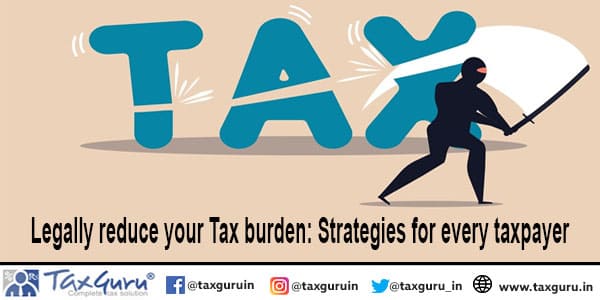Legally reduce your Tax burden: Strategies for every taxpayer
Abstract
Are taxes overwhelming you? From a lawyer’s perspective, this extensive book is intended to enable professionals and individuals to legally lower their tax burden by navigating the complicated tax landscape. We will demystify the idea of taxes by describing their intent and typical modes of payment. This guide’s main focus will be on practical tactics that can reduce your tax liability. We will provide you with important information on everything from employing tax-advantaged accounts for healthcare and business costs to optimizing deductions and credits like charitable contributions and retirement plan contributions. We will look at particular deductions for business owners that can drastically lower their tax obligations. In order to maximize your tax savings, we will also go over income management strategies and assist you in choosing between itemized and standard deductions. We stress the value of speaking with a trained tax professional throughout this book. A professional can make sure you are lawfully taking advantage of all available deductions and credits, optimizing your tax savings, and gaining better financial stability because tax regulations are complicated and vary by place. Do not forget that your prospective tax benefits increase with the sooner you begin planning. With the help of this book, you’ll be able to manage your tax status and retain more of your hard-earned money.
Introduction
Tax time of year. Two phrases that have the power to make even the most well-organized professionals fearful. To be honest, understanding the world of tax laws and deductions can be like trying to understand a foreign language. However, what if we told you there was a method to turn tax season from a hated obligation into a powerful chance to retain more of your hard-earned cash? From the viewpoint of a lawyer, this extensive book is your key to discovering the techniques for lawfully lowering your tax burden. Here, we’ll dissect the foundations of taxes and outline several approaches to completing your duties. Above all, we will provide you with an effective toolkit of tactics that you can apply irrespective of your filing status or income level.
This tutorial is intended to empower you, regardless of your level of experience filing taxes. We will examine various payment choices, examine the motivations and procedures underlying taxes, and—above all—disclose legal strategies to reduce your tax liability. So take a cup of coffee (or your favorite beverage) and set aside the stress. Our goal is to turn tax season from a chore into a calculated chance to become financially independent. Together, let’s take this journey to learn how you can confidently and lawfully keep more of your money in your pocket.
What are Taxes? From a Lawyer’s Perspective
One way to think about taxes is as monetary payments that people and companies make to the government. These monies are gathered and utilized to support social security, infrastructure, healthcare, education, and national defense, among other vital public services.

Different Ways to Pay Taxes
Various payment options are available for taxes, contingent on your filing status and source of income. Typical methods include the following:
1. Payroll Withholding: Throughout the year, employers deduct income taxes from each paycheck received by salaried staff members. This guarantees a progressive payment of taxes.
2. Estimated Tax Payments: You must make estimated tax payments all year long if you work for yourself, are self-employed, freelance, or receive income from sources other than a regular salary (such as rental income).
3. Tax Filing and Payment: You must file a tax return with the appropriate tax authorities (such as the Internal Revenue Service (IRS) in the US) after the tax year ends, which is normally on December 31st. This return lists all of your income and deductions, which helps to calculate how much tax you owe. Tax payments can be paid online, with a check, or using other authorized channels.
Understanding State and Local Taxes
State and municipal taxes can differ greatly, leading to a patchwork of rates and laws, while federal taxes are the same throughout the nation. It is important to comprehend these differences, particularly if you plan to move or are handling revenue from numerous states.
Breakdown of State and Local Taxes
Taxes of many kinds are used by state and municipal governments to pay for necessities like public safety, infrastructure, and education. Several typical tax forms are as follows:
1. Income Tax: Wages, salaries, and other types of income are subject to an income tax in 41 states as well as the District of Columbia. From zero percent in some states to over thirteen percent in others, the numbers differ greatly.
2. Sales Tax: A sales tax is levied on goods and services that consumers purchase by the majority of states and numerous municipalities. The rates differ as well; some states have a base rate plus additional local sales taxes, while others have no sales tax at all. Even special exclusions for certain commodities, like groceries or clothing, exist in some areas.
3. Property Tax: Based on the assessed value of real estate, which includes buildings and land, local governments impose property taxes. This is a significant source of income for school districts and municipalities. Depending on your region and property valuation, there might be significant differences in property tax rates.
4. Additional Taxes: States and municipalities may furthermore levy other taxes, such as estate taxes, hotel occupancy taxes, and excise taxes on cigarettes and gasoline.
Understanding Tax Rate Variations
Financial planning requires an understanding of the regional variations in these taxes. Here are a few instances:
1. Variations in Income Taxes: High-income individuals seeking to minimize their tax liability may be drawn to states like Alaska, Texas, Florida, and Nevada that do not impose income taxes. To make money, these jurisdictions, however, frequently rely significantly on other taxes, such as sales taxes.
2. Sales Tax Variations: The overall cost of living may be lower in states with high sales taxes, such as Tennessee (around 9.5% including local taxes) and California (over 7.25%). But for repeated transactions, the sales tax might mount up quite a bit.
3. Variations in Property Taxes: Depending on where you live, property tax rates can vary significantly. Although states like Connecticut and New Jersey have high property taxes, they can be burdensome for homeowners despite having good public services. Conversely, states with lower property taxes—like Alabama and Hawaii—might also provide public services of worse quality.
Impact of State and Local Taxes on Your Finances
Making wise selections requires having a thorough understanding of how local and state taxes may affect your finances. Here are some things to think about:
1. Cost of Living Calculations: State and municipal taxes, in addition to housing prices, must be taken into account when assessing the cost of living. It might not be as advantageous as it seems to have a reduced cost of living in a state with high sales taxes.
2. Planning for Relocation: Look into the state and local tax ramifications if you are thinking about moving. Relocating to a state with lower income taxes but higher property taxes might not be the most cost-effective choice, depending on your income level and financial circumstances.
3. Handling Multi-State Income: You might have to submit more tax returns if you have income from several states. You can reduce your tax liability and negotiate these complexity by speaking with a tax specialist.
Effective Strategies to Reduce Your Tax Liability: As a professional, it is essential to explore strategies that can legally minimize your tax burden.
Here are some crucial strategies to think about:
1. Optimize Credits and Deductions: By deducting allowable expenses from your taxable income, you can lower your total tax obligation. Charitable contributions, mortgage interest, student loan interest payments, above-a-certain-dollar medical expenses, and business-related costs for self-employed people are a few examples of deductions. Furthermore, tax credits immediately reduce your tax liability by a certain sum of money. Common examples are the Child Tax Credit for parents and the Earned Income Tax Credit (EITC) for low- and moderate-income earners.
2. Make Tax-Advantaged Account Contributions: Your taxable income for the year can be reduced by making contributions to employer-sponsored plans like 401(k)s or tax-advantaged retirement accounts like IRAs (Individual Retirement Accounts). The money in these accounts grows tax-deferred, so contributions and gains are not subject to taxes until you take them out in retirement, maybe at a lower tax rate. Another tax-advantaged option for medical spending is a Health Savings Account (HSA), provided that high-deductible health insurance policies are also in place.
3. Plan Your Deductions for firm Owners: You can deduct a larger variety of costs if you are self-employed or the owner of a firm. This covers depreciation on equipment, office supplies, business travel, home office expenses (within reasonable bounds), and marketing costs. You can maximize your business-related deductions by consulting with a tax expert.
4. Handle Your Revenue: It can be helpful to understand the tax ramifications of various income streams. For instance, long-term asset sales, like those of stocks held for more than a year, may result in capital gains that are taxed at a lower rate than regular income. You can also reach the deduction level by combining some deductions, including medical costs, into a single tax year.
5. Itemized vs. Standard Deduction: Under the tax code, you have the option of itemizing your deductions or claiming the government-provided standard deduction. It’s critical to carefully consider your individual deductions in order to decide which option will save you the most money on taxes.
Conclusion: Taking Control and Building Financial Security
Although paying taxes is an inevitable aspect of life, it doesn’t have to be a continual cause of anxiety. You may drastically lower your tax liability and keep more of your hard-earned money by comprehending the principles of tax filing and carefully weighing your options. Thanks to this essay, you now have a strong base on which to lawfully reduce your tax liability.
It’s crucial to keep in mind, though, that tax regulations are always changing and that new tactics could be developed every year. Take into account the following actions to stay ahead of the curve:
1. Establish a Tax Planning Routine: Review your income, expenses, deductions, and potential credits each year, ideally well in advance of tax season. By being proactive, you may plan ahead and make sure that you don’t pass on any opportunities. The procedure can be made simpler by utilizing technology, such as internet information or tax preparation software.
2. Remain Up to Date: To stay informed about new deductions or credits, as well as changes to tax laws, subscribe to reliable tax periodicals and websites.
3. Seek Professional Advice: It is strongly advised that you speak with a trained tax professional if you have complicated tax circumstances, a sizable income, or considerable assets. They can guide you through complex tax regulations, offer tailored tax planning advice, and make sure you take full advantage of all allowable credits and deductions. Over time, this investment may save you a significant sum of money.
In the end, reaching financial security involves more than merely lowering your tax burden. To lay a strong financial foundation, it is worthwhile to investigate other tactics including budgeting, prudent debt management, and calculated investments. Recall that achieving financial security is a process rather than a goal. You can successfully follow the route to financial well-being and accomplish your long-term financial goals by regularly managing your taxes, remaining informed, and possibly seeking professional advice.
Finally, remember that this text is only meant to be a general reference and is not intended to be tax advice. Always seek the advice of a licensed tax professional for tailored advice based on your unique situation. Recall that the potential benefits increase with the early planning and implementation of tax-saving initiatives. Assume responsibility for your financial situation, reduce your tax liability, and prepare for a more stable financial future.





